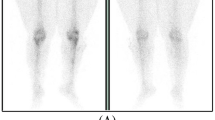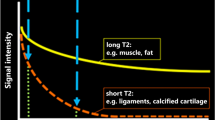Abstract
Objective
Quantitative bone scintigraphy is a useful method to diagnose sacroiliitis. However, there is significant overlap between healthy and pathological sacroiliac index (SI) values for adult patients, while there are no such sufficient data for children. This study was aimed mainly to assess normal SI values in different age groups of pediatric patients using 2 different quantitative methods.
Materials and methods
Normally reported bone scans of 79 children were retrospectively reviewed. Two different methods were used for quantitation. For the first method, sacrum was used as a background site while L5 vertebra was used instead for the second method. Right/left SI values of both methods were compared with each other in relation with gender and different age groups, as group 1 (1–5 years), group 2 (6–10 years), group 3 (11–15 years) and group 4 (16–18 years). Additional comparison was made with a group of young-adult population of 21–30 years old as group 5 to assess the effect of age.
Results
Gender-based comparison yielded significantly higher SI for females for the first method, while no significant difference existed for the second one. Significant increase in SI with both methods was found as age increased. Significantly lower SI was found from the second method, when similar age groups like group 1–2 or group 2–3 were compared with each other, while no such difference existed for the first method. For each individual patient from any age group, method-based comparison resulted in a significantly different SI with both methods.
Conclusions
In pediatric population, SI tends to increase as age increases. Quantitation method using sacrum as background yields significantly higher SI for female gender. Alternative use of L5 as background site for quantitation performs well in children. Since two methods resulted in significantly different SI, individualized cut-off values for each age group for any method are practically warranted.

Similar content being viewed by others
References
Burgos-Vargas R. The assessment of the spondyloarthiritis international society concept and criteria for the classification of axial spondyloarthritis and peripheral spondyloarthritis:A critical appraisal for the pediatric rheumatologist. Pediatric Rheumatol Online J. 2012;31:10(1):14. http://www.ped-rheum.com/content/10/1/14.
Braun J, van der Heijde D. Imaging and scoring in sacroiliitis. Best Pract Res Clin Rheumatol. 2002;16(4):573–604.
Gong Y, Zheng N, Chen SB, Xiao ZY, Wu MY, Liu Y, et al. Ten years’ experience with needle biopsy in the early diagnosis of sacroiliitis. Arthritis Rheum. 2012;64(5):1399–406. doi:10.1002/art.33453.
Inanc N, Atagündüz P, Sen F, Biren T, Turoğlu HT, Direskeneli H. The investigation of sacroiliitis with different imaging techniques in spondyloarthropathies. Rheumatol Int. 2005;25(8):591–4 (Epub 2004).
Grigoryan M, Roemer FW, Mohr A, Genant HK. Imaging in sacroiliitis. Curr Rheumatol Rep. 2004;6(2):102–9.
Bozkurt MF, Uğur O, Ertenli I, Caner B. Combined use of bone and bone marrow scintigraphies for the diagnosis of active sacroiliitis. Ann Nucl Med. 2001;15(2):117–21.
Fogelman I, Maisey MN, Clarke SEM. Sacroiliitis. In: Fogelman I, Maisey MN, Clarke SEM, editors. An atlas of clinical nuclear medicine. 2nd ed. Singapore: Martin Dunitz Ltd; 1994. p. 84.
Ryan PJ, Fogelman I. Sacroiliac quantitative bone scintigraphy in ankylosing spondylitis:any clinical relevance? Nucl Med Commun. 1993;14:19–20.
Davis MC, Turner MA, Charters JR, Golden HE, Ali A, Fordham EW. Quantitative sacroiliac scintigraphy:the effect of method of selection of region of interest. Clin Nucl Med. 1984;9:334–40.
Huanga JY, Tsaib MF, Kaoc PF, Chena YS. Automatic computer-aided sacroiliac joint index analysis for bone scintigraphy. Comput Methods Programs Biomed. 2010;98(1):15–26. doi:10.1016/j.cmpb.2009.07.010 (Epub 20).
Ayres J, Hilson AJ, Maisey MR, Laurent R, Panayi GS, Saunders AJ. An improved method for sacroiliac joint imaging:a study of normal subjects, patients with sacroiliitis and patients with low-back pain. Clin Radiol. 1981;32:441–5.
Prakash S, Gopinath PG, Bhargava S, Mehra NK, Malaviya AN. Evaluation of quantitative sacroiliac scintigraphy for the early detection of sacroiliitis. Eur J Nucl Med. 1983;8:531–4.
Lin WY, Wang SJ. Influence of age and gender on quantitative sacroiliac joint scintigraphy. J Nucl Med. 1998;39:1269–72.
Wu MS, Chang SS, Lee SH, Lee CC. Pyogenic sacroiliitis—a comparison between paediatric and adult patients. Rheumatology. 2007;46:1684–7.
Taylor ZW, Ryan DD, Ross LA. Increased incidence of sacroiliac joint infection at a children’s hospital. J Pediatr Orthop. 2010;30(8):893–8.
Stoll ML, Bhore R, Dempsey-Robertson M, Punaro M. Spondyloarthritis in pediatric population: risk factors for sacroiliitis. J Rheumatol. 2010;37(11):2402–8. doi:10.3899/jrheum.100014 (Epub 2010 Aug 3).
Lassman M, Biassoni L, Monsieurs M, Franzius C, Jacobs F. EANM dosimetry and paediatrics committees. The new EANM paediatric dosage card. Eur J Nucl Med Mol Imaging. 2009;36(3):540–1.
Conflict of interest
None declared.
Author information
Authors and Affiliations
Corresponding author
Rights and permissions
About this article
Cite this article
Bozkurt, M.F., Kiratli, P. Quantitative sacroiliac scintigraphy for pediatric patients: comparison of two methods. Ann Nucl Med 28, 227–231 (2014). https://doi.org/10.1007/s12149-013-0799-0
Received:
Accepted:
Published:
Issue Date:
DOI: https://doi.org/10.1007/s12149-013-0799-0




